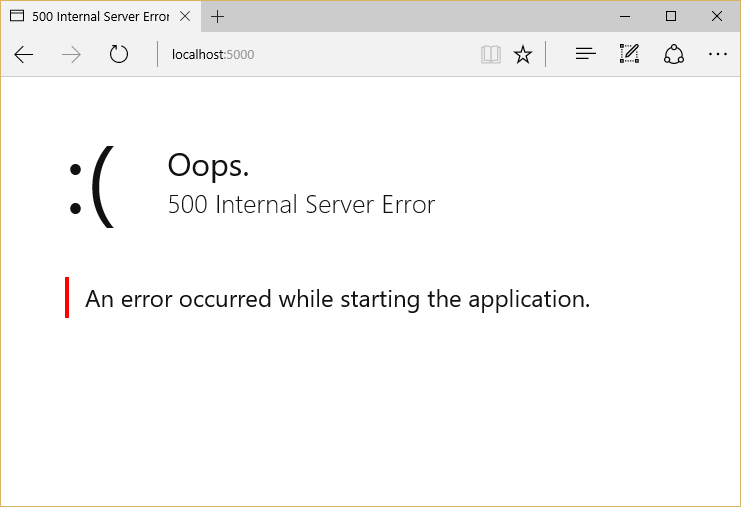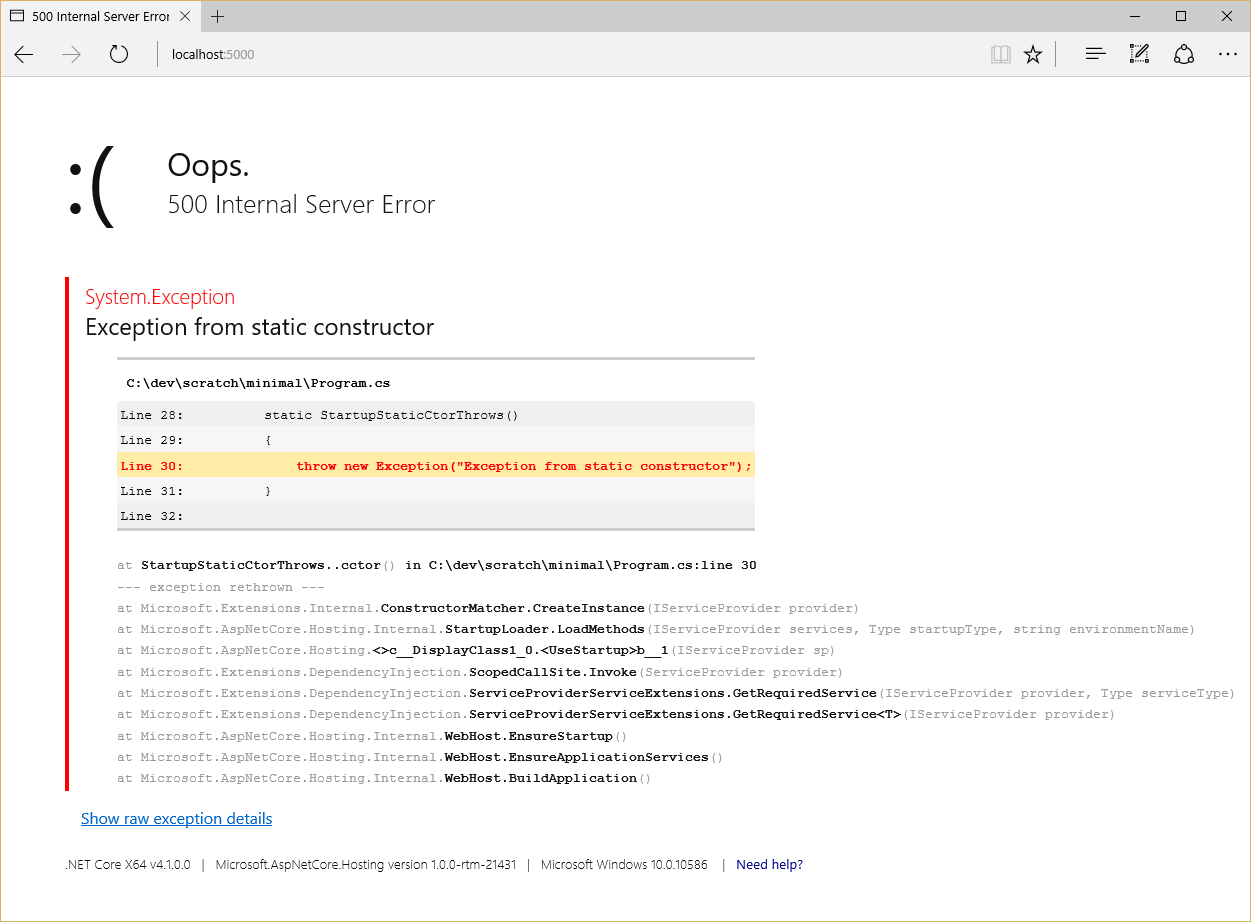Hosting¶
By Steve Smith
To run an ASP.NET Core app, you need to configure and launch a host using WebHostBuilder.
What is a Host?¶
ASP.NET Core apps require a host in which to execute. A host must implement the IWebHost interface, which exposes collections of features and services, and a Start method. The host is typically created using an instance of a WebHostBuilder, which builds and returns a WebHost instance. The WebHost references the server that will handle requests. Learn more about servers.
What is the difference between a host and a server?¶
The host is responsible for application startup and lifetime management. The server is responsible for accepting HTTP requests. Part of the host’s responsibility includes ensuring the application’s services and the server are available and properly configured. You can think of the host as being a wrapper around the server. The host is configured to use a particular server; the server is unaware of its host.
Setting up a Host¶
You create a host using an instance of WebHostBuilder. This is typically done in your app’s entry point: public static void Main, (which in the project templates is located in a Program.cs file). A typical Program.cs, shown below, demonstrates how to use a WebHostBuilder to build a host.
using System;
using System.Collections.Generic;
using System.IO;
using System.Linq;
using System.Threading.Tasks;
using Microsoft.AspNetCore.Hosting;
namespace WebApplication1
{
public class Program
{
public static void Main(string[] args)
{
var host = new WebHostBuilder()
.UseKestrel()
.UseContentRoot(Directory.GetCurrentDirectory())
.UseIISIntegration()
.UseStartup<Startup>()
.Build();
host.Run();
}
}
}
The WebHostBuilder is responsible for creating the host that will bootstrap the server for the app. WebHostBuilder requires you provide a server that implements IServer (UseKestrel in the code above). UseKestrel specifies the Kestrel server will be used by the app.
The server’s content root determines where it searches for content files, like MVC View files. The default content root is the folder from which the application is run.
주석
Specifying Directory.GetCurrentDirectory as the content root will use the web project’s root folder as the app’s content root when the app is started from this folder (for example, calling dotnet run from the web project folder). This is the default used in Visual Studio and dotnet new templates.
If the app should work with IIS, the UseIISIntegration method should be called as part of building the host. Note that this does not configure a server, like UseKestrel does. To use IIS with ASP.NET Core, you must specify both UseKestrel and UseIISIntegration. Kestrel is designed to be run behind a proxy and should not be deployed directly facing the Internet. UseIISIntegration specifies IIS as the reverse proxy server.
주석
UseKestrel and UseIISIntegration are very different actions. IIS is only used as a reverse proxy. UseKestrel creates the web server and hosts the code. UseIISIntegration specifies IIS as the reverse proxy server. It also examines environment variables used by IIS/IISExpress and makes decisions like which dynamic port use, which headers to set, etc. However, it doesn’t deal with or create an IServer.
A minimal implementation of configuring a host (and an ASP.NET Core app) would include just a server and configuration of the app’s request pipeline:
var host = new WebHostBuilder()
.UseKestrel()
.Configure(app =>
{
app.Run(async (context) => await context.Response.WriteAsync("Hi!"));
})
.Build();
host.Run();
주석
When setting up a host, you can provide Configure and ConfigureServices methods, instead of or in addition to specifying a Startup class (which must also define these methods - see 어플리케이션 시작하기). Multiple calls to ConfigureServices will append to one another; calls to Configure or UseStartup will replace previous settings.
Configuring a Host¶
The WebHostBuilder provides methods for setting most of the available configuration values for the host, which can also be set directly using UseSetting and associated key. For example, to specify the application name:
new WebHostBuilder()
.UseSetting("applicationName", "MyApp")
Host Configuration Values¶
- Application Name
string - Key:
applicationName. This configuration setting specifies the value that will be returned fromIHostingEnvironment.ApplicationName. - Capture Startup Errors
bool - Key:
captureStartupErrors. Defaults tofalse. Whenfalse, errors during startup result in the host exiting. Whentrue, the host will capture any exceptions from theStartupclass and attempt to start the server. It will display an error page (generic, or detailed, based on the Detailed Errors setting, below) for every request. Set using theCaptureStartupErrorsmethod.
new WebHostBuilder()
.CaptureStartupErrors(true)
- Content Root
string - Key:
contentRoot. Defaults to the folder where the application assembly resides (for Kestrel; IIS will use the web project root by default). This setting determines where ASP.NET Core will begin searching for content files, such as MVC Views. Also used as the base path for the Web Root setting. Set using theUseContentRootmethod. Path must exist, or host will fail to start.
new WebHostBuilder()
.UseContentRoot("c:\\mywebsite")
- Detailed Errors
bool - Key:
detailedErrors. Defaults tofalse. Whentrue(or when Environment is set to “Development”), the app will display details of startup exceptions, instead of just a generic error page. Set usingUseSetting.
new WebHostBuilder()
.UseSetting("detailedErrors", "true")
When Detailed Errors is set to false and Capture Startup Errors is true, a generic error page is displayed in response to every request to the server.

When Detailed Errors is set to true and Capture Startup Errors is true, a detailed error page is displayed in response to every request to the server.

- Environment
string - Key:
environment. Defaults to “Production”. May be set to any value. Framework-defined values include “Development”, “Staging”, and “Production”. Values are not case sensitive. See Working with Multiple Environments (류지형님). Set using theUseEnvironmentmethod.
new WebHostBuilder()
.UseEnvironment("Development")
주석
By default, the environment is read from the ASPNETCORE_ENVIRONMENT environment variable. When using Visual Studio, environment variables may be set in the launchSettings.json file.
- Server URLs
string - Key:
urls. Set to a semicolon (;) separated list of URL prefixes to which the server should respond. For example, “http://localhost:123”. The domain/host name can be replaced with “*” to indicate the server should listen to requests on any IP address or host using the specified port and protocol (for example, “http://:5000” or “https://:5001”). The protocol (“http://” or “https://”) must be included with each URL. The prefixes are interpreted by the configured server; supported formats will vary between servers.
new WebHostBuilder()
.UseUrls("http://*:5000;http://localhost:5001;https://hostname:5002")
- Startup Assembly
string - Key:
startupAssembly. Determines the assembly to search for theStartupclass. Set using theUseStartupmethod. May instead reference specific type usingWebHostBuilder.UseStartup<StartupType>. If multipleUseStartupmethods are called, the last one takes precedence.
new WebHostBuilder()
.UseStartup("StartupAssemblyName")
- Web Root
string - Key:
webroot. If not specified the default is(Content Root Path)\wwwroot, if it exists. If this path doesn’t exist, then a no-op file provider is used. Set usingUseWebRoot.
new WebHostBuilder()
.UseWebRoot("public")
Use 설정 to set configuration values to be used by the host. These values may be subsequently overridden. This is specified using UseConfiguration.
public static void Main(string[] args)
{
var config = new ConfigurationBuilder()
.AddCommandLine(args)
.AddJsonFile("hosting.json", optional: true)
.Build();
var host = new WebHostBuilder()
.UseConfiguration(config)
.UseKestrel()
.Configure(app =>
{
app.Run(async (context) => await context.Response.WriteAsync("Hi!"));
})
.Build();
host.Run();
}
In the example above, command line arguments may be passed in to configure the host, or configuration settings may optionally be specified in a hosting.json file. To specify the host run on a particular URL, you could pass in the desired value from the command line:
dotnet run --urls "http://*:5000"
The Run method starts the web app and blocks the calling thread until the host is shutdown.
host.Run();
You can run the host in a non-blocking manner by calling its Start method:
using (host)
{
host.Start();
Console.ReadLine();
}
Pass a list of URLs to the Start method and it will listen on the URLs specified:
var urls = new List<string>() {
"http://*:5000",
"http://localhost:5001"
};
var host = new WebHostBuilder()
.UseKestrel()
.UseStartup<Startup>()
.Start(urls.ToArray());
using (host)
{
Console.ReadLine();
}
Ordering Importance¶
WebHostBuilder settings are first read from certain environment variables, if set. These environment variables must use the format ASPNETCORE_{configurationKey}, so for example to set the URLs the server will listen on by default, you would set ASPNETCORE_URLS.
You can override any of these environment variable values by specifying configuration (using UseConfiguration) or by setting the value explicitly (using UseUrls for instance). The host will use whichever option sets the value last. For this reason, UseIISIntegration must appear after UseUrls, because it replaces the URL with one dynamically provided by IIS. If you want to programmatically set the default URL to one value, but allow it to be overridden with configuration, you could configure the host as follows:
var config = new ConfigurationBuilder()
.AddCommandLine(args)
.Build();
var host = new WebHostBuilder()
.UseUrls("http://*:1000") // default URL
.UseConfiguration(config) // override from command line
.UseKestrel()
.Build();
Additional resources¶
- Publishing to IIS
- Publish to a Linux Production Environment
- Hosting ASP.NET Core as a Windows Service
- Hosting ASP.NET Core Embedded in Another Application